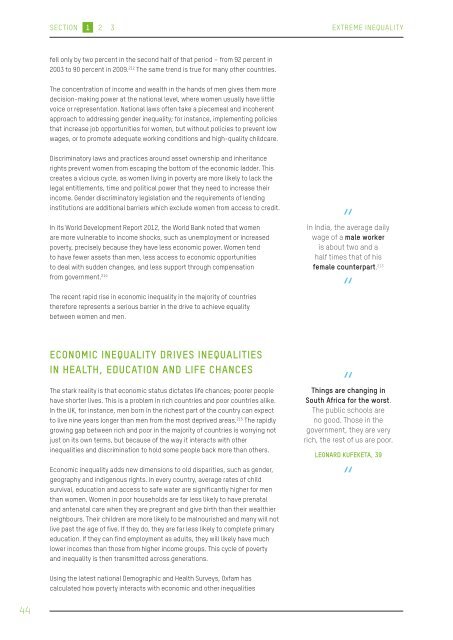1FW2e8F
1FW2e8F
1FW2e8F
Create successful ePaper yourself
Turn your PDF publications into a flip-book with our unique Google optimized e-Paper software.
SECTION 1 2 3<br />
EXTREME INEQUALITY<br />
fell only by two percent in the second half of that period – from 92 percent in<br />
2003 to 90 percent in 2009. 212 The same trend is true for many other countries.<br />
The concentration of income and wealth in the hands of men gives them more<br />
decision-making power at the national level, where women usually have little<br />
voice or representation. National laws often take a piecemeal and incoherent<br />
approach to addressing gender inequality; for instance, implementing policies<br />
that increase job opportunities for women, but without policies to prevent low<br />
wages, or to promote adequate working conditions and high-quality childcare.<br />
Discriminatory laws and practices around asset ownership and inheritance<br />
rights prevent women from escaping the bottom of the economic ladder. This<br />
creates a vicious cycle, as women living in poverty are more likely to lack the<br />
legal entitlements, time and political power that they need to increase their<br />
income. Gender discriminatory legislation and the requirements of lending<br />
institutions are additional barriers which exclude women from access to credit.<br />
In its World Development Report 2012, the World Bank noted that women<br />
are more vulnerable to income shocks, such as unemployment or increased<br />
poverty, precisely because they have less economic power. Women tend<br />
to have fewer assets than men, less access to economic opportunities<br />
to deal with sudden changes, and less support through compensation<br />
from government. 214<br />
The recent rapid rise in economic inequality in the majority of countries<br />
therefore represents a serious barrier in the drive to achieve equality<br />
between women and men.<br />
“<br />
In India, the average daily<br />
wage of a male worker<br />
is about two and a<br />
half times that of his<br />
female counterpart. 213<br />
“<br />
ECONOMIC INEQUALITY DRIVES INEQUALITIES<br />
IN HEALTH, EDUCATION AND LIFE CHANCES<br />
The stark reality is that economic status dictates life chances; poorer people<br />
have shorter lives. This is a problem in rich countries and poor countries alike.<br />
In the UK, for instance, men born in the richest part of the country can expect<br />
to live nine years longer than men from the most deprived areas. 215 The rapidly<br />
growing gap between rich and poor in the majority of countries is worrying not<br />
just on its own terms, but because of the way it interacts with other<br />
inequalities and discrimination to hold some people back more than others.<br />
Economic inequality adds new dimensions to old disparities, such as gender,<br />
geography and indigenous rights. In every country, average rates of child<br />
survival, education and access to safe water are significantly higher for men<br />
than women. Women in poor households are far less likely to have prenatal<br />
and antenatal care when they are pregnant and give birth than their wealthier<br />
neighbours. Their children are more likely to be malnourished and many will not<br />
live past the age of five. If they do, they are far less likely to complete primary<br />
education. If they can find employment as adults, they will likely have much<br />
lower incomes than those from higher income groups. This cycle of poverty<br />
and inequality is then transmitted across generations.<br />
“<br />
Things are changing in<br />
South Africa for the worst.<br />
The public schools are<br />
no good. Those in the<br />
government, they are very<br />
rich, the rest of us are poor.<br />
LEONARD KUFEKETA, 39<br />
“<br />
Using the latest national Demographic and Health Surveys, Oxfam has<br />
calculated how poverty interacts with economic and other inequalities<br />
44


